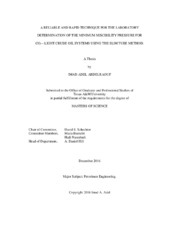| dc.description.abstract | Minimum miscibility pressure is a crucial parameter for the design of any gas injection project. The techniques used for MMP determination can be categorized into either experimental or computational methods. Computational methods are convenient and fast. However, they do not lead to accurate values and are mainly used when only an approximation is needed. Experimentally, the most common ways of determining MMP are the slim tube method, the rising bubble method, and the method of vanishing interfacial tension. The vanishing interfacial tension and the rising bubble methods do not entirely address the multi-contact mechanisms. On the other hand, the slim tube experiment is considered to be the most accurate way to determine the MMP since it simulates the 1-D displacement of the reservoir crude oil by the injected CO2 fully accounting for the thermodynamic phenomena taking place in the CO2-oil system inside a sand packed coil.
I present a technique that enables the determination of the minimum miscibility pressure of a CO2 – light crude oil system at low reservoir temperatures using a short 20 ft. slim tube in less than two weeks, about a third of what it normally takes using the conventional 80 ft. slim tube.
MMP is a crucial parameter in designing a CO2 enhanced oil recovery project and its value needs to be known with a degree of accuracy that cannot be provided by the use of equations of state or correlations, and therefore, needs to be determined experimentally. The slim tube technique is recognized to be the most accurate experimental method for determining the MMP. However, its use has not been favored because it is time-consuming.
The MMP for various CO2 – crude oil systems were determined from the North Burbank Unit and the Oklahoma/Texas Panhandle. The reduction in the length of the slim tube from 80 ft. to 20 ft. resulted in a decrease in the total time of the experiment. The validity of the technique was proven by performing recovery factor measurements using a conventional 80 ft. long slim tube. The MMP values obtained are valid when the length of the slim tube is sufficient to host the mixing zone and the velocity of the displacement is slow enough to enable the transverse dispersion to eliminate viscous fingering. In the case of light oil at low temperatures, the use of the 20 ft. slim tube is justified as the length of the mixing zone is shorter. The results are also supported by the use of numerical simulation.
The reduction in the time required for slim tube experiment results in a fast, economical and accurate technique for the determination of MMP in CO2 – light crude oil systems. Taking into account that CO2 flooding is the most applied EOR technique in the US and that it is mainly applied to light oil reservoirs, this work can be of great impact by providing a rapid and reliable method for determining the MMP for designing a CO2 enhanced oil recovery project. | en |


